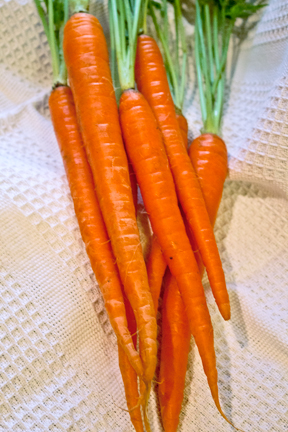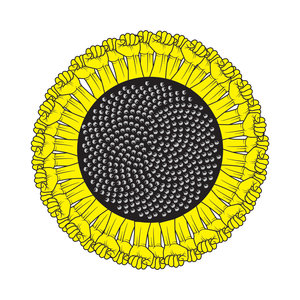Carrots, Growing, Not Manufactured
 Manufactured carrots? Yes, but not in an evil scientist, GMO way. The baby carrots that are so popular today, have an interesting history. When they first appeared on the market, they started out as carrots that were deemed not market worthy. They were cut from these shamed carrots.
Mike Yurosek of Newhall, California, a carrot farmer came up with this idea, and in
the process, he revolutionized carrot breeding, and the carrot industry. You can read his story here.
Manufactured carrots? Yes, but not in an evil scientist, GMO way. The baby carrots that are so popular today, have an interesting history. When they first appeared on the market, they started out as carrots that were deemed not market worthy. They were cut from these shamed carrots.
Mike Yurosek of Newhall, California, a carrot farmer came up with this idea, and in
the process, he revolutionized carrot breeding, and the carrot industry. You can read his story here.
If you look at the package label, baby-cut carrots are shaped out of larger carrots, and baby carrots are either carrots harvested early, or varieties that are full-sized, small carrots. You can also tell the difference by the shape of the shoulder, and if the carrots still have the skin on. If it has a true carrot shoulder, and the skin, you know it's not cut from a larger carrot.
It seems odd to refer to a naturally grown carrot whittled down to as a smaller version as a manufactured carrot, however, while researching this post, I kept coming across the term. I think it's great that a use was found for what was once scrap because of its shape or appearance. The scraps from the cutting process are used for juicing or for animal feed. Also, because of this process, carrot consumption has risen. According to snopes.com;
"Baby-cuts" are part of a sharp upsurge in the carrot's popularity in the U.S. Between 1970 and 1986, Americans ate 6 pounds of carrots per person per year. However, American consumption of carrots began to take off in 1987, and by 2002 it had reached <11 pounds per person.
Quite a good story all around I would say. It ties into a challenge of growing carrots. Carrots need soft, rock free soil at a preferred depth of twelve inches to grow long and straight. You always want to provide the optimum growing environment for your plants. While you might not mind knobby or fork shaped carrots, which can happen with hard soil or rocks in the path of the root growing down, this will add stress to the plant, and that's never a good thing.
To clear the soil for carrot beds, or for any root vegetable for that matter, you can sift it through a screen. You can also double dig, or use containers that you fill with soft, rock free soil. Raised beds are ideal since you're adding the soil to raised bed you can ensure that it will be soft and rock free.
Whatever method you choose, add in about a 1 inch layer of mature compost, or vermicompost, which is compost processed by worms. It's a great addition to your soil.
Direct sow your seeds. Carrot seeds are very small, so be careful handling them. Some suggest mixing them with an equal amount of sand to seed for spreading the mixture, and others suggest seed tapes. Whatever method you're comfortable with, sow them a quarter-inch deep, approximately 2" apart, and space the rows approximately a foot apart. Double and triple rows are ok, depending on the space you have available. If you do double or triple rows, try succession planting a week apart. This will extend your harvest for 2 or 3 weeks depending on how you time the succession planting. If you are using containers, keep the same spacing between plants. Don't crowd the container, or the row.
If you can't do twelve inches in your bed, or you have really hard soil, work with what you have. While the twelve inch dept is ideal, you can always plant Paris Market Carrots, a small round variety.
Carrots are slow germinators, be patient with them. Also, you can plant quick-growing radishes with them to mark where the row, and to break the soil. Just be sure to remove all the radishes when they sprout. Carrots don't like crowds, so mulch the rows to keep weeds at bay, and keep the soil evenly moist during the germination period.
You can plant them in the spring before the last frost, but the soil temperature needs should be at least 60 degrees. They can tolerate a light frost. They do better with phosphorous and potassium instead of nitrogen, so keep the manure away. They don't like acidic soil. A pH of 5.8-7 is best. If you test your soil and it's below the 5.8 pH number, use lime to raise the pH.
Harvest them when the carrots show a rich color, cut the tops off, wash and store them in a refrigerator or a cool root cellar.
Row covers are universally suggested to combat the carrot fly. Companion planting suggests that sage, lavender or rosemary mask the aroma of carrots that attract the carrot fly, and Allium, (leeks, shallots etc) confuse the carrot fly. Carrot Museum.co.uk however says this rarely works. They have details here on dealing with this pest.
That's how you grow them, next week it's what kind to grow. That will be fun!
